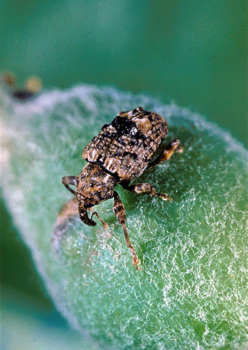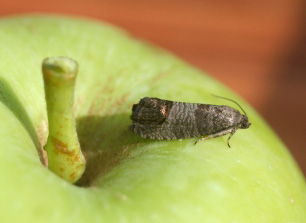ATTRA Identification Sheet: Apple Insects
By Tammy Howard and Guy K. Ames, NCAT Agriculture Specialists
There are several key insects that affect apple production. Use this handy guide to help identify some insect pests and to learn more about causes and solutions. For more specific information about these insects, or to learn about apple insects not addressed here, see the ATTRA publication Apples: Organic Production Guide.
Insects

Plum curculio adult. Photo: Clemson University, Bugwood.org
Plum Curculio
Plum curculio is a small brownish weevil or snout beetle found in the eastern United States.
After mating, the female bores a small hole in the skin of a developing fruit, deposits a single egg, and then makes a crescent cut below the hole to protect the egg from being crushed by the growing fruit.
Internal fruit damage is caused by burrowing larvae, resulting in premature fruit drop (“June drops”)
Adults feed on fruit in late summer and fall. Feeding wounds are frequently the first sign of adult presence.

Codling moth. Photo: Whitney Cranshaw, Bugwood.org
Codling Moth
The codling moth, Cydia pomonella, is a small, indistinct gray adult moth that flies mostly at night, so often goes unseen unless trapped.
Presence of “frass” at stem or calyx end of fruit indicates larval feeding inside fruit.
The codling moth is present throughout North American apple-growing regions.
Relatively cold regions may have only one generation of the codling moth, while in the warmest apple-growing areas the codling moth may pass through two to three generations per season.

Apple maggot. Photo: Joseph Berger, Bugwood.org
Apple Maggot
The apple maggot, Rhagoletis pomonella, is primarily found in the Northeast and the upper Midwest.
Adult is a small, black fly with striped abdomen and wings.
The adult life cycle of apple maggot is much later than plum curculio and codling moth.

Oriental fruit moth. Photo: G. Morvan, Bugwood.org
Oriental Fruit Moth
A direct pest of the fruit that tunnels randomly throughout the flesh, not just around the seed cavity.
Fruit moth larvae often feed on succulent shoot tips.
Adult moth is similar to the related codling moth and, likewise, rarely seen except in traps.

Flathead borer. Photo: James Solomon, Bugwood.org
Borer
Two species of flatheaded borers invade apple trees: Chrysobothris femorata in the East and mali on the Pacific coast.
Adults emerge from woodland trees in late April through early May and begin laying eggs beneath bark scales on the tree. The graft union is a favorite place for egg deposition.
The roundheaded apple tree borer, Saperda candida, attacks the tree near ground level.
The dogwood borer, Synanthedon scitula, feeds primarily on burr knot tissue on clonal rootstocks.
Look for signs of borer damage, such as frass mixed with sawdust at the base of the tree and at the pest’s entry hole.
Key Low-Spray and Organic Solutions
Plum Curculio
Biological monitoring—systematically scouting the orchard to detect the presence or measure the population density of pests—provides critical information for choosing and timing control strategies. Surround WP kaolin clay-based crop protectant is a plum curculio management option. It is a nontoxic particle film that places a barrier between the pest and its host plant. The standard Surround spray program for plum curculio starts at first petal fall and continues for six to eight weekly sprays or until the infestation is over. Surround can be combined with mass trapping of curculio adults to reduce numbers of subsequent generations. Disking the orchard during the pupal period (“cocoon stage”) is a method of mechanical control effective for the following production year. Poultry and ranging hogs foraging in the orchard for larvae in fruit drops and adult beetles can help control curculio, although adherence to food safety requirements is necessary when livestock are in the orchard.
Codling Moth
Among the most effective nontoxic controls for codling moth is mating disruption using pheromones. This approach faces two general problems—difficulties with sustaining an even, long-lasting distribution of pheromones throughout the orchard and complications due to the biology and initial distribution of the codling moth. For organic growers it will probably not be feasible to achieve adequate suppression using mating disruption alone, but combining it with black-light traps improves control. Degree-day monitoring can help determine the best timing for spray applications. A granulosis virus, originally identified from codling moth, has been shown to be effective for control of early-stage codling moth larvae. The trichogramma wasp is increasingly used in U.S. orchards as a biological control organism against codling moth. Sanitation and cultural practices can help reduce codling moth populations. Surround WP kaolin clay-based crop protectant deters insects in several ways. The standard Surround spray program for first-generation codling moth starts at first petal fall and continues for six to eight weekly sprays or until the infestation is over.
Apple Maggot
To monitor adult population levels, red spheres covered with a sticky coating and impregnated with a fly-attracting odor are hung in the orchard. If enough spheres are used, the flies can be mass trapped. This technique may reduce or eliminate the need for pesticide applications. Removing hawthorns and abandoned or neglected apple trees near the orchard should help in reducing fly influx into the orchard. The flies are susceptible to pyrethrum, rotenone, and diatomaceous earth. Also, recent research on Surround particle film has shown it to manage maggot populations within acceptable levels if sprayed shortly after fruit set.
Oriental Fruit Moth
The Oriental fruit moth is relatively easy to control with insecticides, especially if sprays are timed by using commercially available pheromone traps. Unfortunately, due to differing life cycles, the sprays for plum curculio and codling moth do not control the Oriental fruit moth. Sprays for this pest are usually needed later in the season, when they may be disruptive to beneficial insects. A pheromone-based mating disruption system (Isomate-M) has proved effective and is registered for use on apples.
Borers
Maintaining trees in good vigor is important first-line protection from borers since a tree in good vigor will be able to drown an invading larva with sap. Drought-stressed trees are much more susceptible to borers; therefore, adequate water is essential. Removing serviceberry trees (Amelanchier spp.) in close proximity to the orchard may help control roundheaded borer because the serviceberry is a preferred host. Planting so that the graft or bud union is within one inch of the soil should inhibit the development of burr knots, thereby preventing dogwood borer attack. For all species of borers, the larvae can be removed from the trunk with a jackknife or piece of wire. Perhaps the best non-chemical protection from all species of borers is to wrap the bottom 12 to 18 inches of the trunk in window screen (metal, fiberglass, or nylon are all effective). Secure the top with a twist-tie, being certain to loosen and retie it at least once a year. The bottom should be snug against the ground or also secured with a twist-tie.
ATTRA Identification Sheet: Apple Insects
By Tammy Hinman and Guy K. Ames, NCAT Agriculture Specialists
Published November 2014
©NCAT
IP483, slot 495
This publication is produced by the National Center for Appropriate Technology through the ATTRA Sustainable Agriculture program, under a cooperative agreement with USDA Rural Development. ATTRA.NCAT.ORG.


